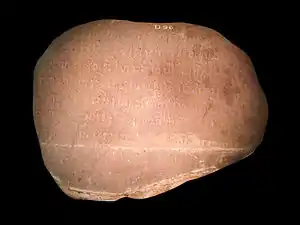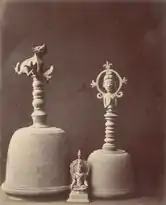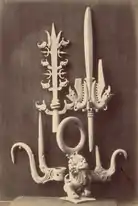Sunda Kingdom
The Sunda Kingdom (Sundanese: ᮊᮛᮏᮃᮔ᮪ ᮞᮥᮔ᮪ᮓ; Karajaan Sunda, Indonesian pronunciation: [sunˈda]) was a Sundanese Hindu kingdom located in the western portion of the island of Java from 669 to around 1579, covering the area of present-day Banten, Jakarta, West Java, and the western part of Central Java. The capital of the Sunda Kingdom moved several times during its history, shifting between the Galuh (Kawali) area in the east and Pakuan Pajajaran in the west.[1]:379
Sunda Kingdom ᮊᮛᮏᮃᮔ᮪ ᮞᮥᮔ᮪ᮓ Karajaan Sunda | |||||||||||||
|---|---|---|---|---|---|---|---|---|---|---|---|---|---|
| 669–1579 | |||||||||||||
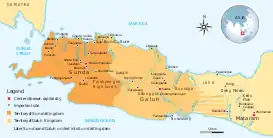 The territory of Sunda Kingdom | |||||||||||||
| Capital | |||||||||||||
| Common languages | Sundanese Sanskrit Cirebonese | ||||||||||||
| Religion | Hinduism Buddhism Sunda Wiwitan | ||||||||||||
| Government | Monarchy | ||||||||||||
| Maharaja | |||||||||||||
• 723–732 | Sanjaya | ||||||||||||
• 1371–1475 | Niskala Wastu Kancana | ||||||||||||
• 1482–1521 | Sri Baduga Maharaja | ||||||||||||
• 1567-1579 | Raga Mulya | ||||||||||||
| History | |||||||||||||
• Coronation of king Tarusbawa and change the name from Tarumanagara to Sunda | 669 | ||||||||||||
| 1579 | |||||||||||||
| Currency | Native gold and silver coins | ||||||||||||
| |||||||||||||
| Today part of | |||||||||||||
Sunda kingdom reach its apogee during the reign of King Sri Baduga Maharaja, whose reign from 1482 to 1521 was remembered as the age of peace and prosperity among Sundanese people. Some historian suggests, that the legendary king Siliwangi of Pajajaran, popular in Sundanese oral tradition and literature, was actually based upon him.[2]:12
According to primary historical records, the Bujangga Manik manuscript, the eastern border of the kingdom was the Pamali River (Ci Pamali, the present day Brebes River) and the Serayu River (Ci Sarayu) in Central Java. Most accounts of the Sunda Kingdom come from primary historical records from the 16th century. Its inhabitants were primarily the eponymous ethnic Sundanese, while the majority religion was Hinduism.
Etymology

The name Sunda derives from the Sanskrit prefix su- which means "goodness" or "possessing good quality". The example is suvarna (lit:"good color") used to describe gold. Sunda is also another name for Hindu God Vishnu. In Sanskrit, the term Sundara (masculine) or Sundari (feminine) means "beautiful" or "excellence".[3][4] The term Sunda also means bright, light, purity, cleanness and white.[5]
The name Sunda is also known in Hindu mythology of Sunda and Upasunda, as one of the powerful Asura brothers that received the boon of invulnerability from Brahma. The powerful Asura brothers then set out to conquering the world, and menacing the Gods. In the end they fought each other over Tilottama, a beautiful Apsara.[6] The story of Sunda and Upasunda is found in the Mahabharata, Book I: Adi Parva. It is not clear however, whether the eponymous Sunda was derived from this Hindu myth.
It seems that by the 10th century, the name Sunda was used by foreigners, possibly by early Indian explorers, Malay Srivijayan traders and colonizer, also Javanese neighbours, as a toponym to identify the Western parts of Java. The Juru Pangambat inscription dated from 854 Saka (932 CE) confirmed this. The name is then used by the Javanese to identify their western neighbour, also rival and enemy, as mentioned in Horren inscription (c. 11th century) from Kediri.
An early 13th century Chinese account reported the pepper port of Sin-t'o (Sunda), which probably refer to the port of Banten or Sunda Kalapa. By the 15th to 16th century, after the consolidation of the kingdom by Sri Baduga Maharaja, the name Sunda has shifted from a possibly eponymous toponymy, into a name that identify a kingdom and its people. Thus subsequently gave birth, name and identity to the ethnogenesis of the Sundanese people. The Sunda Strait that separates islands of Java and Sumatra is also shares its etymology; named after the Sunda Kingdom that once ruled the area on both coasts of the strait.
Historiography
Part of a series on the |
|---|
| History of Indonesia |
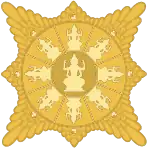  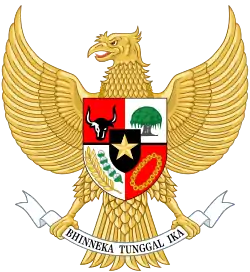 |
| Timeline |
|
|
Knowledge of the kingdom among Sundanese people has been kept alive through Sundanese Pantun oral tradition, the chant of poetic verses about the golden age of Sunda Pajajaran, and the legend of Prabu Siliwangi, the most popular king of Sunda.[7][8]
Several stone inscriptions mention the kingdom, such as Juru Pangambat, Jayabupati, Kawali, and Batutulis. Most account and records of the Sunda Kingdom came from manuscripts dated from a later period circa 15th to 16th century, such as Bujangga Manik, Sanghyang Siksakanda ng Karesian, Carita Parahyangan and Kidung Sunda.
The history of Sunda kingdom is also recorded quite detailed in Pustaka Rajyarajya i Bhumi Nusantara, a book within Wangsakerta manuscripts collection. Composed in late 17th century in Cirebon. However, currently the Wangsakerta manuscripts are generally discounted as a valid historical source among historians, since this controversial manuscript is suspected as a fraud containing pseudohistory.[9][10]
Local account
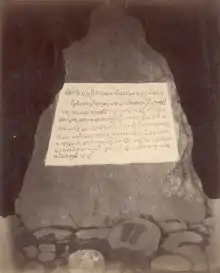
The earliest reference to the name "Sunda" being used to identify a kingdom is the Kebon Kopi II inscription dated 854 Saka (932 CE). The inscription was in old Javanese script, but the language used was Old Malay. It translates as follows:
This memorial stone is to remark the saying of Rakryan Juru Pangambat (Royal Hunter), in 854 Saka, that the order of government is returned to the power of king of Sunda.
Another reference to the kingdom is the Jayabupati inscription which consists of 40 lines written on four pieces of stone found on the Cicatih river bank in Cibadak, Sukabumi. The inscription is written in old Javanese script, mentioned about the establishment of a protected sacred area called Sanghyang Tapak by the King of Sunda named Jayabhupati. The date of the Jayabupati inscription may be 11 October 1030.
Copperplate letters dating to the 15th century, including royal instructions, also imply the existence of the Sunda Kingdom. The copperplate inscription of Kebantenan I (Jayagiri) reads that Raja Rahyang Niskala Wastu Kancana sent an order through Hyang Ningrat Kancana to the Susuhunan of Pakuan Pajajaran to take care of dayohan in Jayagiri and Sunda Sembawa, banning the collection of collecting taxes from the residents because they were knowledgeable about the Hindu religion and worshiped the gods.
Kebantenan II inscription (Sunda Sembawa I) copperplate inscription announces Sri Baduga Maharaja (1482–1521), the king staying in Pakuan, approving an already delineated sacred estate (tanah devasasana) put at the disposal of the wiku (priests), which must not be split as it houses facilities for worship, which belong to the king. Kebantenan III inscription (Sunda Sembawa II) copperplate announces the king of Sunda's sanctions of holy construction in Sunda Sembawa. The Kebantenan IV (Gunung Samaya) inscription says that Sri Baduga Maharaja, who ruled in Pakuan, sanctioned a sacred place (tanah devasana) at Gunung Samya (Mount Rancamaya), the mentions a similar sacred estate to the one described in the Kebantenan II inscription.
The primary source that contains information about the daily life of late 15th to early 16th century Sunda Kingdom was found in Bujangga Manik manuscript. The names of places, culture and customs, was described in great detail, it is one of the important specimen of Old Sundanese literature. The main character is Prince Jaya Pakuan alias Bujangga Manik, a Sundanese Hindu hermit, who, though a prince at the court of Pakuan Pajajaran, preferred to live a life of a man of religion. As a hermit he made two journeys from Pakuan Pajajaran to central and eastern Java and back, the second one including a visit to Bali. After his return he practiced asceticism on a mountain in western Java, where his bodily existence came to an end.[11] The manuscript dated from pre-Islamic Sunda. The language represents an older stage of Sundanese. It displays a marked influence from Javanese but does not contain one word which is tracable to Arabic. In the content of the story, too, Islam is completely absent. This manuscript specifically the mention of Majapahit, Malacca and Demak allow us to date the writing of the story in the 15th century, probably the later part of this century, or the early 16th century at the latest.[12]
Chinese account
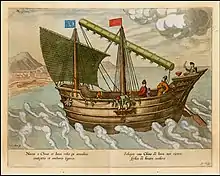
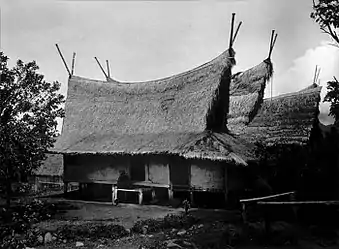
According to F. Hirt and W. W. Rockhill, there are Chinese sources concerning the Sunda Kingdom. At the time of the Southern Sung Dynasty, the inspector of trade with foreign countries, Chau Ju-kua, collected reports from sailors and merchants who had visited foreign countries. His report on far countries, Chu-fan-chi, written from 1178 to 1225 AD, mentions the deepwater harbour of Sin-t’o (Sunda). Chu-fan-chi reported that:
All along the shores, people are dwelling. The people are working in agriculture, their houses are on poles and the roofs are thatched with the bark of the leaves of palm trees and the walls were made with wooden boards tied together with rattan. Both men and women wrap round their loins a piece of cotton, and in cutting their hair they only leave it half an inch long. The pepper grown on the hills (of this country) is small-grained, but heavy and superior to that of Ta-pan (eastern Java). The country produces pumpkins, sugar cane, bottle gourd, beans and egg plants. As, however, there is no regular government in this country, the people are given to brigandage, on which account foreign traders rarely go there.
According to this source, the kingdom of Sunda produced high quality black pepper. The kingdom located in the western parts of Java near Sunda Strait, corresponds to today Banten, Jakarta and west part of West Java province. According to this source, the port of Sunda was under Srivijaya mandala domination. Port of Sunda was highly possible refer to port of Banten instead of Kalapa. Its capital is located 10 kilometres inland southward in Banten Girang near Mount Pulosari.
The Chinese book “shun-feng hsiang-sung" from about 1430 AD relates:
In this voyage eastward from Sunda, along the north coast of Java, ships steered 97 1/2o for three watches to make Kalapa; they then followed the coast (past Tanjung Indramayu), finally steering 187 1/2o for four watches to reach Cirebon. Ships from Banten proceeded eastward along the north coast of Java, past Kalapa, past Indramayu head, past Cirebon.
According to this source the port of Sunda was located west of Kalapa and later identified as port of Banten.
European account
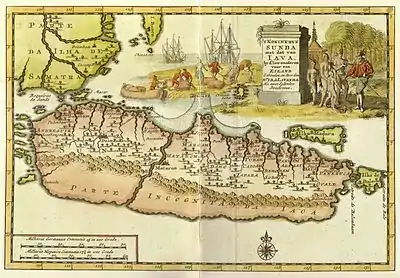
European explorers, mainly Portuguese based in Malacca, also reported the existence of the Sunda Kingdom. Tomé Pires (1513) mentioned a Western Java kingdom that had established trade relation with them as ... Regño de Çumda ..., which means "The Kingdom of Sunda". Also the report of Antonio Pigafetta (1522) that mentioned Sunda as a pepper producing region.[1]:381
Tomé Pires from Portugal wrote in his report “Summa Oriental (1513–1515)”:
Some people affirm that the Sunda kingdom take up half of the whole island of Java; others, to whom more authority is attributed, say that the Sunda kingdom must be a third part of the island and an eight more. It ends at the river chi Manuk. The river intersects the whole island from sea to sea in such away that when the people of Java describe their own country, they say that it is bounded to the west by island of Sunda. The people hold that whoever passes this strait (the river Cimanuk) into the South Sea is carried off by violent currents and unable to return.[13]
The Portuguese report is dated from a later period of the kingdom, shortly before its fall to forces of the Sultanate of Banten.
History
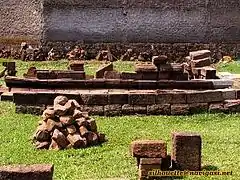
The history of Sunda Kingdom spanned for almost a millennium, between 7th to 16th century. One of the few remnants is the 7th century Bojongmenje Hindu temple near Bandung. It was one of the earliest temple structures in Java, older than temples of Dieng in Central Java, and linked to the Sunda Kingdom.
The earlier period is unclear, much owed to only two manuscripts dated from much later period, the Carita Parahyangan and Wangsakerta manuscripts. The history of later period however, after late 14th century, is quite clear. Especially after the reign of King Wastu Kancana and Sri Baduga Maharaja. This is contributed mainly to the availability of historical sources, including numbers of foreign reports, especially Portuguese Suma Oriental; several stone inscriptions especially Batutulis; and native primary historical manuscripts of Bujangga Manik and Sanghyang Siksakanda ng Karesian.
Formation and growth

According to the Wangsakerta manuscript, King Tarusbawa succeeded his father-in-law as the king of Tarumanagara. He was crowned on 18 May 669, and he possibly sent envoy to Tang court in China in the same year.[14]:54 In 670 Tarusbawa renamed Tarumanagara to the Sunda Kingdom.
According to the Wangsakerta manuscript, Wretikandayun, the lord of Galuh, used the establishment of the Sunda Kingdom as an excuse to split eastern Taruma from Sunda. To avoid civil war, King Tarusbawa granted Wretikandayun's demand and in 670 Tarumanagara was divided into two kingdoms: the Sunda Kingdom in the west, and the Galuh Kingdom in the east, separated by the Citarum River. In the following years, Tarumanagara's power had been declining due to a series of Srivijaya invasions as mentioned in Kota Kapur inscription (686).
Wretikandayun of Galuh has two sons; Sempakwaja and Mandiminyak. Despite being the eldest son, Sempakwaja was not chosen as the successor because of his physical defect. Thus, his younger brother, Mandiminyak inherited the throne. Sempakwaja has a son named Purbasora, while King Mandiminyak also has a son named Sena or Bratasena.
Sena and Sanjaya
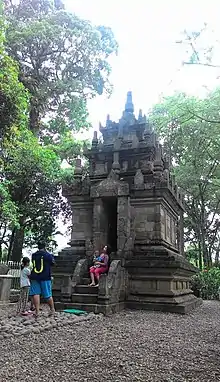
After the death of Mandiminyak, Prince Bratasena (Sanna or Sena), ascends as the new king; as the third monarch of Galuh. According to Carita Parahyangan and Wangsakerta manuscripts; King Sena of Galuh married to Princess Sannaha of Kalingga in Central Java, and they had Jamri (Sanjaya) as their son. Felt more deserving to the throne of Galuh, Purbasora usurped Sena in 716. Defeated, Sena fled to Central Java.
Princess Tejakencana; the granddaughter of Tarusbawa, married Rakeyan Jamri; son of Sena. In 723, Jamri succeeded Tarusbawa as the second king of Sunda. As the lord of Sunda, he was known as Prabu Harisdarma and later he was known as Sri Sanjaya.
Sanjaya determined to take revenge to Purbasora and prepared an attack. The raid was launched at nightfall, and almost all of Purbasora's family was killed. Sanjaya installed Premana Dikusuma, grandson of Purbasora, in charge of Galuh. Sanjaya chose to live in central Java, and later established the Mataram Kingdom in 732. He appointed his son, Prince Tamperan (Rakeyan Panaraban) to rule western Java on his behalf.
Rakryan Juru Pangambat
According to Kebon Kopi II inscription, dated from 932, discovered near Bogor, a skilled hunter named Juru Pangambat, declared that the authority is restored to the king of Sunda.[1]:381 This inscription was written in Kawi alphabet, however curiously the language being used is Old Malay. Archaeologist F. D. K. Bosch, proposed that this suggests Srivijayan influence. French historian, Claude Guillot proposed that this was a declaration of independence of Sunda Kingdom, possibly from Srivijaya.
Jayabupati
According to Sanghyang Tapak inscription, dated from 1030 found in Cibadak near Sukabumi, Maharaja Sri Jayabupati established a sacred sanctuary of Sanghyang Tapak. Curiously, the style of the inscriptions reveal an East Javanese script, language, and style; akin to Dharmawangsa's court of Medang. This has led to suggestions that Sunda Kingdom at this time probably was under the influence of East Java, or probably Jayabupati subscribed to Javanese culture.
Sri Jayabupati in Carita Parahyangan is mentioned as Prabu Detya Maharaja. The 11th century Horren inscription of Southern Kediri, reported that çatru Sunda (enemy from Sunda) had invaded and menacing villages in East Java.[1]:388
After Sri Jayabupati, there is no stone inscription discovered mentioning the next ruler. There is no tangible evidence discovered from the period between 11th to 14th century. Most of our current knowledge about this period came from Carita Parahyangan and Wangsakerta manuscripts.
The Song Chinese source, Chu-fan-chi circa 1200, mentioned that Srivijaya still ruled Sumatra, the Malay peninsula, and Sin-to (Sunda). The source describes the port of Sunda as strategic and thriving, pepper from Sunda being among the best in quality. The people worked in agriculture and their houses were built on wooden poles (rumah panggung). However, robbers and thieves plagued the country.[15] The port of Sunda referred by Chou Ju-kua probably referred to Banten, instead Sunda Kelapa. It seems that by early 13th century, the maritime trade was still dominated by Srivijayan mandala based in Sumatra.
Golden age
The name "Sunda" appeared in Javanese source, the Pararaton, reported that in 1336, during the inauguration of his newly appointed position as Prime Minister, Gajah Mada declared Palapa oath, which stated his foreign policy to unify the archipelago under Majapahit domination. Gajah Mada said "Lamun huwus kalah nusantara isun amukti palapa, lamun kalah ring Gurun, ring Seran, Tañjung Pura, ring Haru, ring Pahang, Dompo, ring Bali, Sunda, Palembang, Tumasik, samana isun amukti palapa". Sunda was mentioned as one of kingdoms targeted by Mada's overseas campaign. It seems by early 14th century, Kingdom of Sunda has grown quite prosperous and took part in international maritime trade.
Maharaja Lingga Buana
The Carita Parahyangan and Pararaton named him as Prěbu Maharaja, while Wangsakerta give a detailed name of Prabu Maharaja Lingga Buana. He ruled in Kawali Galuh, and died in the Battle of Bubat, Majapahit, in 1357, fell victim to a stratagem crafted by the Majapahit prime minister, Gajah Mada.[16]
Hayam Wuruk, the king of Majapahit, intended to marry Princess Dyah Pitaloka, the daughter of Prabu Maharaja. Delighted, the Sunda king and his royal family came to Majapahit, to marry off his daughter to Hayam Wuruk. The Sunda party erected the encampment on Bubat square in the northern part of Trowulan, and awaited the proper wedding ceremony. Gajah Mada however, saw this event as an opportunity to demand Sunda's submission to Majapahit overlordship, and insisted that the princess was to be presented as a token of submission.
Angered and humiliated, the Sunda king call to cancel the wedding and to return home, resulting in a skirmish between the Sunda royal family and the Majapahit army. Outnumbered; almost the entire Sundanese party, including the princess, perished in this tragedy. Tradition mentioned that Princess Dyah Pitaloka committed suicide to defend the honour of her country. After his death, Prabu Maharaja was revered as Prabu Wangi (lit. king with pleasant fragrance) for his heroic defence of his honour. Thus his descendants, the later kings of Sunda, were called Siliwangi (lit. successor of Wangi). The story is the main theme of the book Kidung Sunda.
Niskala Wastu Kancana and Ningrat Kancana
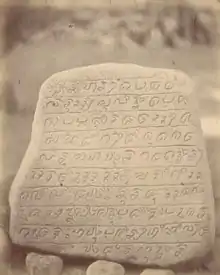
King Niskala Wastu Kancana was the youngest son of Prabu Maharaja and the brother of Princess Pitaloka Citraresmi, both perished in Majapahit. In 1371, Prince Wastu ascended to throne, stylized as Prabu Raja Wastu Kancana. According to Kawali inscription, approximately dated from second half of the 14th century, King Prabu Raja Wastu constructed the defensive structures; walls and moats surrounding Kawali city, and renovated Surawisesa palace.[17] The construction of moats and other defensive measures, was probably as a response to a perceived foreign threat. Since the relations between Sunda and its eastern neighbour, the powerful Majapahit empire, was badly deteriorated after the Bubat incident.[16] Niskala Wastu resided in Kawali palace of Galuh, and ruled for 104 years (1371–1475).[1]:392 His reign is remembered as a long era of peace and prosperity.
The copperplate inscription of Kebantenan I (Jayagiri) reads that Raja Rahyang Niskala Wastu Kancana sent an order through Hyang Ningrat Kancana to the Susuhunan of Pakuan Pajajaran to take care of dayohan in Jayagiri and Sunda Sembawa, banning the collection of taxes from the residents because they were knowledgeable about the Hindu religion and worshiped the gods.
According to Batutulis inscription, Rahyang Niskala Wastu Kancana was buried in Nusalarang, supported by Carita Parahyangan manuscript that mentioned Prebu Niskala Wastu Kancana surup di Nusalarang ring giri Wanakusumah. At this point, the Sunda Kingdom capital was still located in Galuh, more precisely in Kawali city.[1]:391
Niskala Wastu Kancana's son, named as Tohaan di Galuh (Lord of Galuh) in Carita Parahyangan, succeeded him as the king. He was mentioned in Kebantenan I (Jayagiri) inscription as Hyang Ningrat Kancana and in Batutulis inscription as Rahyang Dewa Niskala.
The new king however, reigned for only seven years and subsequently demoted. Carita Parahyangan tell that "... kena salah twa(h) bogo(h) ka estri larangan ti kaluaran ..," which translate as "because (his) wrongdoing, fell in love with a forbidden outsider woman."[1]:393
According to Batutulis inscription, Rahyang Dewa Niskala was buried in Gunatiga. This information is supported by Carita Parahyangan which mentioned that Tohaan di Galuh was nu surup di Gunung Tilu' died or buried in Gunung Tilu. corresponds to Gunung Tilu mountain range located east of the town of Kuningan.[18]
Sri Baduga Maharaja

Sang Ratu Jayadewata or also known as Sri Baduga Maharaja, is a grandson of Prabu Wastu Kancana or Prabu Niskala Wastu. Jayadewata is often linked with a popular character Prabu Siliwangi in the Sundanese oral tradition of pantun.
King Jayadewata moved the government seat from Kawali back to Pakuan in 1482. It is not clear however, the reason behind the transfer of capital westward; it might be a geopolitical move to secure the capital away from the eastern threat from Islamic state of Demak in Central Java. As by 1482, according to Purwaka Caruban Nagari, a Cirebon chronicle, Cirebon declared its independence from Sunda and no longer sent tribute to the Sunda court. Based on Kebantenan copperplate inscription, he established a tanah devasasana sacred estate at Mount Samya or Rancamaya. He also announced the construction of sacred compound in Sunda Sembawa, stipulated as the resident of the priests.
According to Batutulis inscription, Sri Baduga Maharaja built defensive moats surrounding Pakuan Pajajaran; he built gugunungan (sacred mounds), established huts and sacred Samya forest, reserves for wood destined for offerings, and the artificial lake Talaga Rena Mahawijaya (which apparently served as a reservoir[19]). Certainly, there was a good road to Sunda Kalapa (present-day Jakarta Metropolitan city) too, the most important harbour of the Sunda kingdom. At the time of Tome Pirés visit to Pakuan, Sri Baduga Maharaja reigned over the Sunda kingdom (1482 to 1521).
The reign of Ratu Jayadewata was hailed as the "golden age" of the Sundanese people. The kingdom consolidated its rule and exercised power throughout western part of Java. It also marked the era of great prosperity resulting from efficient agriculture management and the thriving pepper trade in the region. This era of great wealth also marked the beginning of Sunda kingdom's decline.
Decline
During the reign of Sang Ratu Jayadewata, there was already a group of Sunda inhabitant that has converted to Islam, as testified by Portuguese account. Tomé Pires in 1513 reported, there is a significant numbers of Muslims resides in the port of Cimanuk (today Indramayu), the easternmost port of Sunda Kingdom. According to Portuguese report, the port of Cirebon which is located just east from Cimanuk, is already a Muslim port by that time, ruled by Javanese.
Probably these new converts were the people referred to in Carita Parahyangan as "those who felt no peace because have strayed from Sanghyang Siksa". Nevertheless, during this time, Islamic influence has not yet penetrated inland into the capital. As mentioned in Carita Parahyangan ... mana mo kadatangan ku musuh ganal, musu(h) alit ..., which means the capital is "safe from rough/coarse enemy, (as well as) soft/subtle enemy". The term "coarse enemy" refer to actual invading foreign army, while "subtle enemy" refer to the propagation of a new faith or new religion that might upset the established spiritual order of the kingdom.[1]:394
The Kingdom of Sunda anxiously watched the growing influence of the expansive Islamic Sultanate of Demak that finally succeed to destroy Daha, the remnant of Hindu Majapahit court, in 1517. As a result of this event, only Blambangan in the eastern edge of Java, and Sunda in the western part remained Hindu kingdoms in Java. Meanwhile, in the land of Sunda, Muslim influences start to penetrated the kingdom.
Rise of Muslim States, Cirebon and Banten
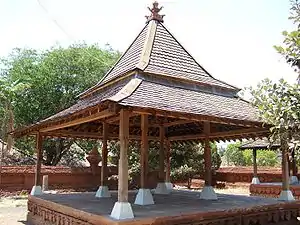
Bujangga Manik manuscript, written circa the second half of 15th century (1450–1500) reported that the eastern boundary of Sunda Kingdom realm was the Cipamali river in present-day Brebes. However, the Portuguese Suma Oriental in 1513 reported that the eastern border of Sunda Kingdom is located in the port of Chemano (Cimanuk), the estuarine of Manuk River. This means between 1450 and 1513 the Sunda kingdom has lost control on the area surrounding Cirebon; between Brebes and Indramayu. This signify the coastal Muslim Javanese push westward into once a traditional Sundanese area, as Demak Sultanate was responsible as the patron for the rise of Cirebon.
The detail of Sunda Kingdom and its relations with the rise of Cirebon Sultanate, mostly were taken from the account of Purwaka Caruban Nagari, a manuscript of Cirebon chronicle which claimed Cirebon as the rightful successor of Sunda Kingdom.
According to Purwaka Caruban Nagari, Sunda King Siliwangi married Nyai Subang Larang, daughter of Ki Gedeng Tapa, port master of Muara Jati (today Cirebon). They had three children; Prince Walangsungsang, Princess Rara Santang, and Prince Kian Santang.[20] Although Prince Walangsungsang was the first-born son of Sunda King, the prince did not earned the right as a crown prince of Sunda Kingdom. This was because his mother, Nyai Subang Larang was not the 'queen consort. Another reason was because of his conversion to Islam, probably influenced by his mother, Subang Larang, a Muslim woman. In 16th century West Java, the state's religion was Hinduism, Sundanese ancestral religion and Buddhism. It was his half brother, King Siliwangi's son from his third wife Nyai Cantring Manikmayang, who was chosen as the crown prince.
Walangsungsang, established a new settlement called Dukuh Alang-alang on 1445. After Ki Gedeng Alang-Alang's death in 1447, Walangsungsang appointed as the ruler of the town and established a court and assumed a new title as Prince Cakrabuana. King Siliwangi sent his envoy Tumenggung Jagabaya and Raja Sengara, to bestow Prince Carkrabuana with the title Tumenggung Sri Mangana. Cirebon grew into a thriving port, yet Cakrabuana still loyal to his father and sent tribute to the main court of Sunda. At that time Cirebon was still a principality within Sunda Kingdom.
In 1479, Cakrabuana was succeeded by his nephew, Sharif Hidayatullah, the son of Nyai Rara Santang (Syarifah Mudaim) and Sharif Abdullah of Egypt. He married his cousin, Nyi Mas Pakungwati daughter of Cakrabuana. He is popularly known with his posthumously name Sunan Gunung Jati. In 2 April 1482, Sunan Gunungjati stated that Cirebon will no longer send tribute to Pajajaran, which marked the proclamation; that now the Sultanate of Cirebon is independent from Sunda Pajajaran.[20]
The character described in Purwaka Caruban Nagari, as King Siliwangi, matched the historic character of Dewa Niskala or Ningrat Kancana, referred as Lord of Galuh in Carita Parahyangan. Tohaan di Galuh was the son and heir of Niskala Wastu Kancana. Ningrat Kancana however, reigned for only seven years and subsequently demoted. Carita Parahyangan tell that "... kena salah twa(h) bogo(h) ka estri larangan ti kaluaran ..," which translate as "because (his) wrongdoing, fell in love with a forbidden outsider woman." The term "outsider woman" is interesting and has led to various proposition; could it be the new king fell in love with a foreigner, outsider, non-Sundanese, or even non-Hindu (Muslim) woman. It is possible that the outsider forbidden woman mentioned here was Nyai Subang Larang.
The pressure from coastal Javan Islamic states drove the king of Sunda, Sri Baduga Maharaja, to seek assistance from the Portuguese at Malacca. In 1512 and again in 1521, he sent his son, the crown prince Prabu Surawisesa also known as Ratu Sang Hyang (Samian) to Malacca to request the Portuguese to sign an alliance treaty, to trade in pepper and to build a fort at his main port of Sunda Kalapa. Sunan Gunung Jati's son later also established the Sultanate of Banten, which later become a menace for Hindu Sunda kingdom.
Surawisesa and Sunda–Portuguese Treaty 1522
After Sri Baduga Maharaja's death in 1521, the succeeding kings, Prabu Surawisesa Jayaperkosa, also known as Ratu Sang Hyang whom the Portuguese called Ratu Samian, faced the menace of Cirebon and Demak. Under this threat, Prabu Surawisesa Jayaperkasa, who reigned from 1521 to 1535, concluded the treaty with Portuguese from Malacca to establish a warehouse and fortress at Sunda Kelapa in return for protection against the menace of these Islamic Sultanates.
By 1522, the Portuguese were ready to form a coalition with the King of Sunda to get access to his lucrative pepper trade. The commander of Malacca, Jorge de Albuquerque, sent a ship, the São Sebastião, under Captain Henrique Leme, to Sunda Kalapa with valuable gifts for the king of Sunda. Two written sources describe the concluding of the treaty in detail, the original Portuguese document of 1522 with the text of the treaty and the signatories of the witnesses, and a report on that event by João de Barros in his book Da Ásia, printed after 1777/78.
The king welcomed them warmly upon their arrival. The crown prince had succeeded his father and was now King Prabu Surawisesa, although Barros called him King Samião. This Sunda ruler agreed to an arrangement of friendship with the King of Portugal and granted a fortress at the mouth of the Ciliwung River where the Portuguese could load as many pepper as they wished. In addition, he pledged, dating from the start of construction on the fortress, each year he would donate one thousand sacks of pepper to the Portuguese king. The contract document was drafted into two copies and signed. On the said day in 1522, Henrique Leme of Portuguese and his entourage together with deputies of the King of Sunda, erected a commemoration stone, called Padrão, at the mouth of the Ciliwung River.
The fall of Sunda Kelapa

This trade and defence treaty was fallen apart tremendously due to Portuguese failure to deliver their promise to construct the fortress in Kalapa. The delay was caused by troubles in Goa. To make things worse, in 1527 Fatahillah, a military general sent from Demak, managed to capture the Sunda Kalapa harbour just before the Portuguese returned.
The army of Paletehan (Fatahillah or Fadillah Khan), comprising around 1452 Cirebon-Demak troops, conquered Sunda Kalapa. The Sunda authority stationed in the port were fallen. The harbour chief and his family, the royal minister, and all of the people working in the harbour were slaughtered. The port city was completely destroyed and razed, as the Sundanese reinforcements sent from Pakuan was too weak and retreated. Sunda Kingdom has lost its most important port, thus subsequently Sunda Kalapa was renamed Jayakarta by its Muslim conqueror.
Thirty Portuguese sailors, shipwrecked by storms, swam to the beach at Kalapa only to be killed by Fadillah Khan's men. The Portuguese recognised the political leadership had changed when they were not allowed to set foot on the land. As they were too weak for a battle, they set sail back to Malacca. The next year, a second attempt failed because of striking sailors angry at not having been paid.
The failure to rely on Portuguese assistance has led Sunda Kingdom to fend for their own survival by themselves. Carita Parahyangan mentioned that during his 14 years of reign (1521–1535), King Sang Hyang (Surawisesa) has fought in 15 battles. Unbeatable, all in which he managed to repel the series of invading Muslim forces from Cirebon and Demak. He fought in Kalapa, Tanjung, Ancol Kiji, Wahanten Girang, Simpang, Gunung Batu, Saung Agung, Rumbut, Gunung, Gunung Banjar, Padang, Panggoakan, Muntur, Hanum, Pagerwesi, and Medangkahyangan.[1]:398
The war between Cirebon-Demak forces and the Sunda kingdom lasted for almost five years. The king lost around 1000 of his men. During this war, after Sunda Kalapa, Sunda Kingdom also lost Banten. Sunan Gunungjati of Cirebon crowned his son, Hasanudin, as the king of Banten under the auspices of the Sultan of Demak who, in turn, offered Hasanudin his sister's hand in marriage. Banten was established as the capital of this new sultanate, held as a province under Sultanate of Cirebon.[21] Finally, in 1531, a peace treaty was concluded between King Surawisesa of Sunda and Syarif Hidayatullah of Cirebon.
In an apparent sorrow after the tremendous defeat and the loss of his two most important ports, Prabu Surawisesa established the Batutulis inscription in 1533 to commemorate his late father.[22] This action was probably an attempt to spiritually appeal for ancestral guidance and protection against the powerful Muslim enemy that now loomed by the gates. Because of ongoing battles, he often could not stay in his palace in Pakuan Pajajaran.
Ratu Dewata
Prabu Ratu Dewata also known as Sang Ratu Jaya Dewata, was the successor of Prabu Surawisesa, however he was not his son. The reign of Prabu Ratu Dewata between 1535 and 1543 was known as a chaotic and difficult one full of hardship, as Islamic forces from Cirebon and Banten tried for multiple times to capture the Dayeuh Pakuan capital.
During Ratu Dewata reign, the Carita Parahyangan reported several calamities befell the kingdom; there was a sudden attack, a lot of enemies razed the city, thus a mass combat erupted in the grand yard (alun-alun).[1]:398 In this battle, the noble princes were killed. The chaos has widespread across the kingdom, the attack also occurred in Ciranjang and Sumedang. Another terror was the assassination of the rishis, hermits and Hindu priests that resides in the hermitage sanctuaries. It was reported that the Hindu priests and hermits of mandala Jayagiri, were captured and drowned into the sea.[1]:400 It is highly possible that the attack was launched by Muslim states of Banten or Cirebon.[1]:395 This was a devastating attack straight to the spiritual core of the Sundanese Hindu community.
Unable to control the kingdom, instead of fulfilling his duty by maintaining the law and order, Prabu Ratu Dewata retreated himself to become a Raja Pandita (priestly king), submitted himself deeply into religious rituals as an apparently desperate appeal for gods' salvation.[1]:396 By this time, Sunda Kingdom were already isolated and confined to inland.
Last kings and the fall of Sunda kingdom
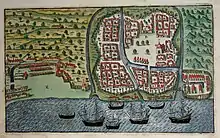
Series of last Sunda kings were notoriously known as incompetent rulers. The successor of Ratu Dewata, King Ratu Sakti reigned from 1543 to 1551, was known as a ruthless king, whom indulge himself with sensual pleasure.[1]:396
The next successor that ruled from 1551 to 1567, King Nilakendra, also known as Tohaan di Majaya, is also an incompetent ruler. Instead of fulfill his duty as a king, he renovate and beautify the palace. Squander kingdom's fortune by indulging himself in pleasures and luxury.[1]:396
Because of ongoing battles, ironically Tohaan di Majaya could not stay in his newly renovated palace. The last kings of Sunda could no longer reside in Pakuan Pajajaran, since in 1550s Hasanuddin, sultan of Banten has launched a successful attack to Dayeuh Pakuan, captured and razed the capital.
The surviving Sunda royalties, nobles and common people fled the fallen city, heading to mountainous wilderness. After the fall of Pakuan Pajajaran, the royal regalia of Sunda Kingdom was evacuated to the eastern principality of Sumedang Larang. Among these regalias are Makuta Binokasih Sanghyang Paké, the royal crown of Sunda. Thus the member of Sunda dynasty established a surviving minor regional kingdom of Sumedang Larang where Sundanese aristocracy would survive for a few more centuries to come, until conquered by Mataram Sultanate in the 17th century.
From 1567 to 1579, under the last king Raja Mulya, also known as Prabu Surya Kencana, the kingdom declined substantially. In Carita Parahyangan, his name is Nusiya Mulya. He ruled further inland in Pulasari, near Pandeglang, at the slope of Mount Palasari. The kingdom has fallen apart, particularly after 1576 due to constant pressure from Banten, and finally collapsed completely in 1579. Thereafter, the Sultanate of Banten took over most of the former Sunda Kingdom's territory, thus ultimately put an end to a millennium of Hindu-Buddhist Dharmic civilization of West Java.[1]:396 By this time, Java has turned more and more Islamic. Only the kingdom of Blambangan on the eastern edge was the last surviving Hindu kingdom in Java, well until its demise in early 18th century.
Capital
Throughout Sunda's history, the centre of cultural and political power often oscillated between Western Priangan region; initially identified as "Sunda", and Eastern Priangan region; traditionally identified as "Galuh". The two traditional sites are located in and around modern Bogor city and the town of Ciamis. Two most important capitals are Pakuan Pajajaran, the capital of Sunda; and Kawali, the capital of Galuh.
Kawali

The capital of Galuh Kingdom of eastern Priangan region, has moved for several times. In older period, the capital was located around the Karang Kamulyan site by the banks of Citanduy river. By early 14th century, the capital was moved further northwest upstream, in the area now known as Astana Gede, near the current town of Kawali, Ciamis Regency. The city was located on eastern slope of Mount Sawal near the source of the Citanduy river. A Kawali inscription was discovered here. According to tradition, the keraton in Kawali is called Surawisesa, expanded and renovated by King Niskala Wastu Kancana. Kawali served as the capital of the kingdom for several generations until Sri Baduga Maharaja moved the government back to Pakuan in 1482.
Pakuan Pajajaran
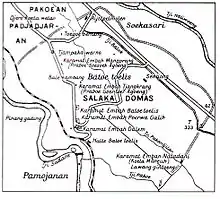
After the fall of Tarumanagara in the 7th century, King Tarusbawa built a new capital city inland near the source of the Cipakancilan river in present-day Bogor. According to Carita Parahyangan, a manuscript from the 15th or 16th century, King Tarusbawa was only mentioned as Tohaan (Lord/King) of Sunda. He was the ancestor of a series of Sunda kings that reigned until 723. Pakuan served as the capital of Sunda during the reign of several kings, and the court shifted to Kawali until Sri Baduga Maharaja moved the court from Kawali back to Pakuan in 1482.
The city was permanently settled since at least the 10th century, but not gaining major political importance until King Jayadewata established it as the royal capital of Sunda kingdom in the 15th century. In 1513, the city was visited by its first European visitor, Tomé Pires, the Portuguese envoy.[23]:40 According to his report, the city of Daio (Dayeuh is a Sundanese term for "capital city") was great city, with population around 50,000 inhabitants.[1]:404
The tradition hailed that King Jayadewata ruled justly from his beautiful Kadatwan (palace) called Sri Bima Punta Narayana Madura Suradipati at Pakuan Pajajaran, and his reign is celebrated as the golden age for Sundanese people.[1]:393
After the reign of King Jayadewata (Sri Baduga Maharaja), Pakuan Pajajaran served as the royal capital for several generations. Dayeuh Pakuan Pajajaran served as the capital of Sunda Kingdom approximately for almost a hundred years (1482 – 1579), until it was razed and destroyed by the Sultanate of Banten in 1579.
Because Pakuan, the capital city of the Sunda kingdom laid between two parallel rivers, Ciliwung and Cisadane, it was called Pajajaran (lit. place laid between two parallel things) or Pakuan Pajajaran. Although primary local and European historical records referred to the kingdom in the western part of Java island as the Sunda Kingdom, the Sundanese, especially after the establishment of the Sultanate of Banten and Cirebon, referred to the kingdom (minus the coastal sultanates) as "Pakuan Pajajaran" Kingdom, or simply as Pakuan Kingdom or Pajajaran Kingdom. The later name – Pajajaran – is more familiar for people residing in West Java and the Javanese of Mataram region (current Yogyakarta and Solo).
Government and economy
Administration
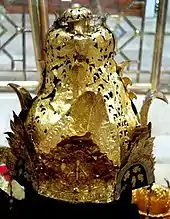
In many historical sources, including manuscripts, inscriptions, as well as foreign historical accounts from China and Portuguese reports, all refer to "Sunda" as a kingdom. On the other hand, the term "Pakuan" and "Pajajaran" or "Dayeuh" refer to its capital which corresponds to the modern city of Bogor. The tangible evidence on the existence of a kingdom as an administrative social structure, was found in Sanghyang Tapak inscription dated 952 Saka (1030 CE), that mentioned Prahajyan Suṇḍa (Sunda Kingdom), with Sri Jayabhupati claimed as haji ri Suṇḍa (the king of Sunda).[1]:402
Through the study on the 14th century inscriptions in Astana Gede site in Kawali, historian suggests that the political model of Sunda Kingdom adhered the concept of Tri Tangtu di Buana, which administrative power was distributed in triad among three elements; Prebu (king), Rama (village chief or regional elder) and Resi (rishi priestly class of religious authority). The concept of Tri Tangtu Buana is somewhat similar to that of Montesquieu's Trias Politica.[24]
According to Tomé Pires report (1513), the Sunda kingdom is ruled by a paramount raja (king or monarch), and the right of throne inheritance descended from a father to his son. However, in the case when a king did not produce a male heir, the successor is elected from the lesser kings, the rulers of regional towns or provinces.[1]:403 These lesser kings is called Tohaan (lord) that acts as local governor, and mostly are related to the king, which means they belongs in the same dynasty.
Much of our current knowledge on detailed social order and the bureaucracy structure of the kingdom, is owed to the Sundanese manuscript of Sanghyang siksakanda ng karesian, compiled around 1518.
...nihan sinangguh dasa prebakti ngaranya. Anak bakti di bapa, ewe bakti di laki, hulun bakti di pacandaan, sisya bakti di guru, wong tani bakti di wado, wado bakti di mantri, mantri bakti di nu nangganan, nu nangganan bakti di mangkubumi, mangkubumi bakti di ratu, ratu bakti di dewata, dewata bakti di hyang ...
This is a reminder which is called "Ten bhakti (devotion)": sons (children) devoted to (their) father, wife devoted to husband, the common people (servants or slaves) devoted to (their) master or employer (pacandaan = place to lean on), students devoted to (their) guru (teacher), farmers devoted to wado (lesser employee), wado devoted to mantri (government official), mantri devoted to nu nangganan (lit. "handler", which refer to managerial position in bureaucracy), nu nagganan devoted to mangkubumi (lord or governor), mangkubumi devoted to ratu (king or monarch), the king devoted to dewata (gods), dewata devoted to hyang (higher spirit).
According to Carita Parahyangan, all of regional ruler (governor), rama (village chief), government officials, and rishi (Hindu priests), are required to make a formal annual visit to the capital; paying homage, tax or tribute to the court. As mentioned in some fragments of this manuscript:
"..., ti Kandangwesi pamwat siya ka Pakwan..." ("... from Kandangwesi the tribute was sent to Pakuan"),
"..., anaking sang Prebu Rama, Resi samadaya sarerea siya marek ka Pakwan unggal tahun..." ("... my son the chief of the village, the rishis together all paid a visit to Pakuan every years").[1]:405
Economy
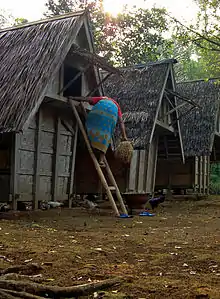
The economy of Sunda kingdom relied on agriculture, especially rice cultivation; this is reflected in Sundanese culture and the annual ceremonies of crop seeding and Seren Taun rice harvest festival. The harvest ceremony also allowed the king's official to collect tax in the form of rice that can be stored in the state's Leuit (rice barn).
According to Siksakanda ng Karesian, Sundanese farmers during the era of Sunda Kingdom did recognize sawah or the wet-field rice cultivation. However, the widespread rice cultivation system applied in the kingdom seems to be the ladang or the dry-field rice which is a much simpler form of cultivation that doesn't require an elaborate social structure to support it. This is corresponds with the geography and topography of West Java which dominated by the central Parahyangan Plateau, in contrast with Central and East Java that consists of river valleys between volcanoes. As the result, compared to Central and East Java, West Java at that time was more sparsely populated, consists of settlements, villages or hamlet quite isolated deep within highland valleys, which render direct administrative control from the kingdom's central government rather difficult.
The kingdom was also well known as the world's main producer of high quality pepper. The kingdom participated in spice trade network in the archipelago. The ports of Sunda participated in international trades in the region.
In Suma Oriental, written in 1512-1515, Tomé Pires, a Portuguese explorer report about the ports of Sunda:
First the king of Çumda (Sunda) with his great city of Dayo, the town and lands and port of Bantam, the port of Pomdam (Pontang), the port of Cheguide (Cigede), the port of Tamgaram (Tangerang), the port of Calapa (Kelapa), and the port of Chemano (Chi Manuk or Cimanuk), this is Sunda, because the river of Chi Manuk is the limit of both kingdoms.[25]
Another Portuguese explorer, Diogo do Couto, wrote that the Sunda kingdom is thriving and abundant; it lies between Java and Sumatra, separated from the latter by the Sunda Strait. Many islands lie along the coast of this kingdom within the strait, for nearly the space of forty leagues; the strait's widest point is about twenty-five and narrowest point only twelve leagues broad. Bantam is about the midpoint. All the islands are well timbered, but have little water. A small one called Macar, at the entrance of Sunda Strait, is said to have much gold.
He also noted that the principal ports of the Sunda kingdom were Banten, Ache, Chacatara (Jakarta), which annually receive twenty sommas, ships from Chienheo, China, to ship the eight thousand bahars, which are equal to 3,000,000 kg of pepper the kingdom produced.
Bantam is situated at 6° south latitude, in the middle of a bay, three leagues from point to point. The town is eight hundred and fifty fathoms in length, and the seaport extends about 400. A river capable of admitting junks and galleys flows through the middle of the town: a small branch of this river admits boats and small craft.
There is a brick fort, the walls of which are seven palms thick, with wooden bulwarks, armed with two tiers of artillery. The anchorage is good, with a muddy or sandy bottom and a depth from two to six fathoms.
Culture and society
Religion
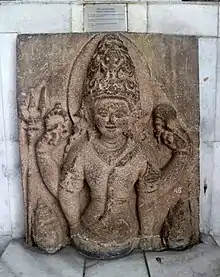
Hinduism was one of the earliest religious influences established in West Java since the era of Tarumanagara, circa early 5th century CE. In fact, West Java was one of the earliest place in Indonesia that being Indianized, also sparked the historic period of Indonesian history by producing the earliest inscription in Java. As Tarumanagara's successor, Sunda Kingdom has inherited this Hindu civilization influences.
The culture of the people in Sunda kingdom blends Hinduism with Sunda Wiwitan; a native shamanism belief, and also a traces of Buddhism is observeable. Several intact prehistoric megalithic sites, such as Cipari site in Kuningan and the Pangguyangan menhir and stepped pyramid in Cisolok, Sukabumi, suggest that native shamanic animism and dynamism beliefs coexisted with Hinduism and Buddhism. The native belief, Sunda Wiwitan, persists today as a way of life for the Baduy or Kanekes people who resist Islam and other foreign influences.
The Cangkuang Hindu temple in Leles, Garut, dated from the 8th century, was dedicated to Shiva and built during the Galuh kingdom. Buddhist influence came to West Java through the Srivijaya conquest, as the empire dominated West Java until the 11th century. The brick stupas in Batujaya indicate Buddhist influence in West Java, while nearby Cibuaya sites show Hindu influence.
The manuscript Carita Parahyangan clearly demonstrate Hinduism spirituality within the Sunda Kingdom society. This manuscript is opened with a legendary character named Sang Resi Guru that had a son named Rajaputra. Comprehensively the manuscript was written by Hindu scholar which demonstrate Hindu frame of references.[1]:379 The Hindu pantheon, such as Brahma, Vishnu, Mahesvara, Rudra, Sadasiva, Yama, Varuna, Kuvera, Indra and Besravaka, were also mentioned in ancient Sundanese manuscript of Sewakadharma or also known as Serat Dewabuda, dated 1357 Saka or 1435 CE.[1]:379
The Sundanese manuscript of spiritual guidance, the Sanghyang Siksakanda ng Karesian also demonstrate Hinduism religious outlook and frame of references, although it seems already mixed with some sorts of Buddhism spirituality. " ... ini na lakukeuneun, talatah sang sadu jati. Hongkara namo Sewaya, sembah ing hulun di Sanghyang Panca Tatagata; panca ngaran ing lima, tata ma ngaran ing sabda, gata ma ngaran ing raga, ya eta ma pahayueun sareanana .., ", " ... this has to be done, the true mandate of the good-hearted (or trusted one). Blessed (should be) in the name of Shiva. Worship the servant to Sanghyang Panca Tatagata (Buddha), panca means five, tata means words, gata means body, yes, that is for the good of all".[1]:379
Sunda Kingdom period did not produce enough archaeological evidences and records that could give comprehensive knowledge about the religious aspects of its population. Yet, there are few interesting things that suggests a syncretism took place between Hinduism, Buddhism, and a form of local beliefs system. This indication emerged from the veneration of Hyang figure, which considered possess higher status than Hindu-Buddhist deities, as it shown in Sanghyang Siksakanda Ng Karesian manucript (1518): "...mangkubumi bakti di ratu, ratu bakti di dewata, dewata bakti di hyang...", which means "...mangkubumi submit to the king, king submit to the gods, and gods submit to hyang..."[26]
Ancient Sundanese society did not built temples that are meticulously decorated with exquisite bas-reliefs as demonstrated in temples built by neighbouring Javanese in central and east Java that flourished around the same era. Furthermore, their statuary such as Shiva from Cangkuang temple and Ganesha from Karang Kamulyan site, were made such in a very simple form, almost has primitive megalithic style and quality. This has led to the suggestion that Hinduism and Buddhism were not truly and fully embraced by the ancient Sundanese populace, because they still rather faithfully adhered to their own vernacular ancestral beliefs system.[26]
Art and culture
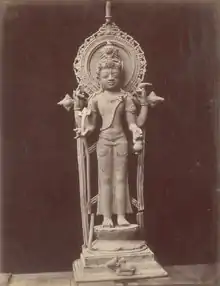
The culture of Sunda kingdom centred on agricultural activity, especially rice cultivation. Nyi Pohaci Sanghyang Asri or Sanghyang Asri, the goddess of rice, is revered as the main deity or the highest goddess within Sundanese pantheon. The priest was concerning about the religious ceremonies and the king and his subjects participated in annual ceremonies and festivals such as the blessing of the rice seeds ceremonies and harvest festival. The annual Seren Taun rice harvest festival is still practised today in traditional Sundanese communities.
According to the Bujangga Manik manuscript, the courtly culture of Sunda kraton and its nobles' etiquette in Pakuan Pajajaran was sophisticated. However no traces of the palace or buildings survived in the former capital, probably because their wood construction decayed over the centuries.
The Portuguese source provide a glimpse of the culture and customs of the Sunda kingdom. In his report “Suma Oriental (1512–1515)” Tomé Pires wrote:
Sunda kingdom is very rich. The land of Sunda has as much as four thousands horses which come there from Priaman (Sumatera) and other islands to be sold. It has up to forty elephants; these are for the king’s array. An inferior gold, of six carats, is found. There is abundance tamarinds which serve the native for vinegar.
The city where the king is most of the year is the great city of Dayo. The city has well-built houses of the palm leaf and wood. They say that the king’s house has three hundred and thirty wooden pillars as thick as a wine cask, and five fathoms (8 m) high, and beautiful timber work on the top of the pillars, and a very well-built house. The city is two days journey from the chief port, which is called Kalapa.
The people of the sea coast get along well with the merchants in the land. They are accustomed to trade. These people of Sunda very often come to Malacca to trade. They bring cargo lancharas, ships of a hundred and fifty tons. Sunda has up to six junks and many lancharas of the sunda kind, with masts like a crane, and steps between each so that they are easy to navigate.[27]
The people of Sunda are said to be truthful. They, with great city of Dayo, the town and lands and port of Bantam, the port of Pontang, the port of Cheguide, the port of Tangaram, the Port of Tangaram, the port of Calapa, the port of chi Manuk. are justly governed. The king is a great sportsman and hunter. The kingdom descends from father to son. The women are handsome, and those of the nobles chaste, which is not the case with those of the lower classes. There are monasteries of convents for the women, into which the nobles put their daughters, when they cannot match them in marriage according to their wishes. The married women, when their husband die, must, as point of honour, die with them, and if they should be afraid of death they put into the convents. The inhabitants are not very warlike, much addicted to their idolatries. They are fond of rich arms, ornamented with gold and inlaid work. Their krises are gilt, and also the point of their lances.
Relations with regional powers
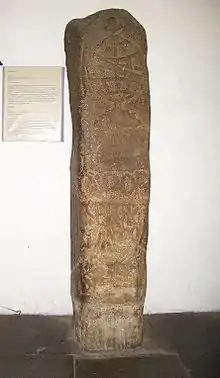
The Kingdom is commonly thought as the successor of Tarumanagara which also flourished in the same location of Western Java. It seems that in its early history, around 10th to 11th century, Sunda Kingdom was stuck in between two competing mandalas; the Malay Srivijaya in Sumatra in the west and its Javanese neighbouring kingdom in the east.
In early of its history, the kingdom seems served as the vassal of Srivijayan mandala. By the 10th century, the kingdom seems to break loose, liberated from Srivijayan mandala as stated by Rakryan Juru Pangambat inscription (932 CE). However, according to the Chinese Song Dynasty book Zhu Fan Zhi,[28] written around 1225 by Zhao Rugua, Sin-t'o (Sunda), was still part of San-fo-tsi (Srivijaya) 15 tributaries.
Kingdom of Sunda has established relations with its eastern neighbour; the kaleidoscope of Javanese kingdoms, from the era of Medang Mataram back in the 8th century, all the way to Majapahit in 14th century and Demak in 16th century.[16] The popular hero, King Sanjaya of Mataram known as the Javanese Mataram King mentioned in Canggal inscription (732), was also mentioned in Sundanese manuscript Carita Parahyangan; as having his root in Sunda Kingdom.
The Sanghyang Tapak inscription (1030) shows Javanese cultural influence, as the style of script, letters, language, and the title of the king is similar to royal names in East Javanese Medang court. However, the relations might be not quite harmonious, as according to 11th century East Javanese Horren inscription, mentioned çatru Sunda, which means the village of Horren was attacked by "the enemy (from) Sunda".[1]:388
The relations between Sundanese and Javanese kingdoms descended to a new low, when a disastrous incident took place in Bubat square in Majapahit in 1357, killing all of Sundanese royal party, including the Sunda king Prabu Maharaja and Princess Tohaan Dyah Pitaloka Citraresmi.[16] This tragedy severely harmed the relationship between the two kingdoms and resulted in hostility for years to come, the situation never again returning to normality.[29]
The nemesis of Hindu Sunda Kingdom was no doubt the Islamic states of Java northern coast; they are the Demak, Cirebon and later the Banten Sultanate.[1]:394 In order to protect the political and spiritual order of the kingdom, also to protect the economic interest of Sunda Kingdom against the menace of Muslim Javanese states, King Sang Ratu Jayadewata seek assistance to the Portuguese based in Malacca.
Sunda Kingdom is known as one of the earliest polity in Southeast Asia that has established diplomatic relations with European nation. The Luso-Sundanese padrão (1522) stone post, commemorating a treaty between the kingdoms of Portugal (based in Malacca) and Sunda. The treaty formed as pepper trade agreement as well as a political alliance against the menace of their common enemies; the Islamic Demak and Cirebon.[30]
Legacy
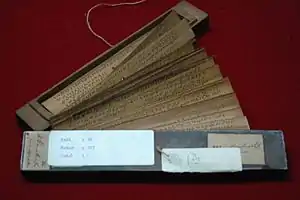
Although the kingdom of Sunda left little archaeological remains, it remains part of culture of Sundanese people being kept alive through the Pantun oral tradition, the chant of poetic verses. According to tradition, the Sunda Kingdom under its legendary king, Prabu Siliwangi, is revered as the prosperous and glorious golden age for Sundanese people.[1]:415 The historical identity and the source of pride for Sundanese, the same as Majapahit for Javanese people. The pantun that mentioned Sunda Kingdom (popularly known as Pakuan or Pajajaran):
Talung-talung keur pajajaran. Jaman keur aya keneh kuwerabekti. Jaman guru bumi dipusti-pusti. Jaman leungit tangtu eusina metu. Euweuh anu tani kudu ngijon. Euweuh anu tani nandonkeun karang. Euweuh anu tani paeh ku jenkel. Euweuh anu tani modar ku lapar (Pantun Bogor: Kujang di Hanjuang siang, Sutaarga 1984:47)
Translation: It was better during the Pajajaran era, when Kuwera (the god of wealth) was still revered. The era when the earth guru was still honoured. The lost era when the essence of teaching are delivered. No farmer had to take loans. No farmer had to sell their lands. No farmer died in vain. No farmer died in hunger.
Dinegara Pakuan sarugih. Murah sandang sarta murah pangan. Ku sakabeh geus loba pare. Berekahna Dewa Guru anu matak kabeh sarugih. Malah ka nagri lain geus kakocap manjur. Dewa Guru miwarangan ka Ki Semar: "maneh Semar geura Indit, leumpangan ka nagri pakuan!" (Wawacan Sulanjana: Plyte 1907:88)
Translation: In the prosperous kingdom of Pakuan, people lacked no food or clothing. Rice was plenteous. The blessing of Dewa Guru laid on the land, so everyone was rich. The land's fame spread to other lands. Dewa Guru ordered Ki Semar to the kingdom of Pakuan!
Several streets in major Indonesian cities, especially in West Java, were named after Sundanese kings and Sunda Kingdom. The street names such as Jalan Sunda in Jakarta and Bandung, Jalan Pajajaran in Bogor and Bandung, Jalan Siliwangi and Niskala Wastu Kancana in Bandung, are among street names named after Kingdom of Sunda. The Padjadjaran University in Bandung was named for Pakuan Pajajaran, the capital and the popular name for the Sunda Kingdom. The TNI Siliwangi Military Division and Siliwangi Stadium was named for King Siliwangi, the eponymous popular king of Sunda. The West Java state museum, Sri Baduga Museum in Bandung is named after king Sri Baduga Maharaja.
List of rulers
Based on Pustaka Rajyarajya i Bhumi Nusantara, the most probable timeline for the rulers of the Sunda kingdom is as follows:
| Period | King's name | Ruler of | Capital | Inscription or Manuscript reference | Events |
|---|---|---|---|---|---|
| 669 – 723 | Tarusbawa | Sunda | Pakuan | Wangsakerta, Pustaka Rajyarajya i Bhumi Nusantara | Tarusbawa renamed the remnant of Tarumanagara Sunda. Separation of Sunda and Galuh |
| 612 – 702 | Wretikandayun | Galuh | Galuh | Wangsakerta, Pustaka Rajyarajya i Bhumi Nusantara | Wretikandayun demanded the partition of Tarumanagara and the separation of Sunda and Galuh |
| 702 – 709 | Mandiminyak | Galuh | Galuh | Wangsakerta, Pustaka Rajyarajya i Bhumi Nusantara | |
| 709 – 716 | Sena/Bratasena | Galuh | Galuh | Wangsakerta, Carita Parahyangan, Pustaka Rajyarajya i Bhumi Nusantara | |
| 716 – 723 | Purbasora | Galuh | Galuh | Wangsakerta, Carita Parahyangan, Pustaka Rajyarajya i Bhumi Nusantara | Purbasora, Wretikandayun's grandson, rebelled against Sena and took the throne of Galuh in 716 |
| 723 – 732 | Sanjaya/Harisdarma/
Rakeyan Jamri |
Sunda, Galuh, and Mataram | Pakuan | Canggal, Wangsakerta, Carita Parahyangan, Pustaka Rajyarajya i Bhumi Nusantara | Sanjaya, son of Sena's sister, Sannaha, married Tarusbawa's daughter, Tejakencana, and become the king of Sunda. He took revenge on Sena's behalf against Purbasora in Galuh. Sanjaya took his right as the heir in Kalingga, established the Sanjaya dynasty and Mataram Kingdom in central Java |
| 732 – 739 | Rakeyan Panaraban/
Tamperan Barmawijaya |
Sunda and Galuh | Galuh | Pustaka Rajyarajya i Bhumi Nusantara | Panaraban, son of Sanjaya, became king of Sunda |
| 739 – 766 | Rakeyan Banga/Hariang Banga | Sunda | Pakuan | Pustaka Rajyarajya i Bhumi Nusantara | Under Srivijaya domination |
| 766 – 783 | Rakeyan Medang Prabu Hulukujang | Sunda | Pakuan | Pustaka Rajyarajya i Bhumi Nusantara | Under Srivijaya domination |
| 783 – 795 | Prabu Gilingwesi | Sunda | Pakuan | Pustaka Rajyarajya i Bhumi Nusantara | Under Srivijaya domination |
| 795 – 819 | Pucukbumi Darmeswara | Sunda | Pakuan | Pustaka Rajyarajya i Bhumi Nusantara | Under Srivijaya domination |
| 819 – 891 | Prabu Gajah Kulon Rakeyan Wuwus | Sunda and Galuh | Pakuan | Pustaka Rajyarajya i Bhumi Nusantara | Under Srivijaya domination |
| 891 – 895 | Prabu Darmaraksa | Sunda and Galuh | Pakuan | Pustaka Rajyarajya i Bhumi Nusantara | Under Srivijaya domination |
| 895 – 913 | Windusakti Prabu Dewageng | Sunda | Pakuan | Pustaka Rajyarajya i Bhumi Nusantara | Under Srivijaya domination |
| 913 – 916 | Rakeyan Kemuning Gading Prabu Pucukwesi | Sunda | Pakuan | Pustaka Rajyarajya i Bhumi Nusantara | Under Srivijaya domination |
| 916 – 942 | Rakeyan Jayagiri Prabu Wanayasa | Sunda | Pakuan | Pustaka Rajyarajya i Bhumi Nusantara | Under Srivijaya domination |
| 942 – 954 | Prabu Resi Atmayadarma Hariwangsa | Sunda | Pakuan | Pustaka Rajyarajya i Bhumi Nusantara | Under Srivijaya domination |
| 954 – 964 | Limbur Kancana | Sunda | Pakuan | Pustaka Rajyarajya i Bhumi Nusantara | Under Srivijaya domination |
| 964 – 973 | Prabu Munding Ganawirya | Sunda | Pakuan | Pustaka Rajyarajya i Bhumi Nusantara | Under Srivijaya domination |
| 973 – 989 | Prabu Jayagiri Rakeyan Wulung Gadung | Sunda | Pakuan | Pustaka Rajyarajya i Bhumi Nusantara | Under Srivijaya domination |
| 989 – 1012 | Prabu Brajawisesa | Sunda | Pakuan | Pustaka Rajyarajya i Bhumi Nusantara | Under Srivijaya domination |
| 1012–1019 | Prabu Dewa Sanghyang | Sunda | Pakuan | Pustaka Rajyarajya i Bhumi Nusantara | Under Srivijaya domination |
| 1019–1030 | Prabu Sanghyang Ageng | Sunda and Galuh | Galuh | Pustaka Rajyarajya i Bhumi Nusantara | Under Srivijaya domination |
| 1030–1042 | Prabu Detya Maharaja Sri Jayabupati | Sunda and Galuh | Pakuan | Jayabupati, Pustaka Rajyarajya i Bhumi Nusantara | Offspring of Srivijaya princess and Sunda King, son in-law of King Dharmawangsa of Medang. Proclaimed independence from Srivijaya by assuming the title "Maharaja". Established the sacred sanctuary of Sanghyang Tapak |
| 1042–1064 | Dharmaraja | Sunda and Galuh | Galuh | Pustaka Rajyarajya i Bhumi Nusantara | |
| 1064–1154 | Prabu Langlangbhumi/
Sang Mokteng Kreta |
Sunda and Galuh | Pakuan | Pustaka Rajyarajya i Bhumi Nusantara | |
| 1154–1156 | Rakeyan Jayagiri/
Prabu Menakluhur Langlangbhumisutah |
Sunda and Galuh | Pakuan | Pustaka Rajyarajya i Bhumi Nusantara | |
| 1156–1175 | Prabu Dharmakusumah/
Sang Mokteng Winduraja |
Sunda and Galuh | Galuh | Pustaka Rajyarajya i Bhumi Nusantara | |
| 1175–1297 | Prabu Guru Dharmasiksa | Sunda and Galuh | Saunggalah, | Carita Parahyangan, Pustaka Rajyarajya i Bhumi Nusantara | Rakeyan Jayadharma, son of Dharmasiksa, married Dyah Lembu Tal of Singhasari, and have a son Wijaya. Jayadharma died in boyhood and Dyah lembu Tal returned to Singhasari. Wijaya later established Majapahit. Rakeyan Saunggalah, Jayadharma's brother, succeeded Dharmasiksa |
| 1297–1303 | Rakeyan Saunggalah/
Prabu Ragasuci |
Sunda and Galuh | Saunggalah | Pustaka Rajyarajya i Bhumi Nusantara | Moved the capital to Saunggalah (currently Kuningan) |
| 1303–1311 | Prabu Citraganda/
Sang Mokteng Tanjung |
Sunda and Galuh | Pakuan | Pustaka Rajyarajya i Bhumi Nusantara | |
| 1311–1333 | Prabu Lingga Dewata/
Sang Mokteng Kikis |
Sunda and Galuh | Kawali | Pustaka Rajyarajya i Bhumi Nusantara | Moved the capital from Pakuan and built a new capital Kawali near the former Galuh capital (currently Ciamis) |
| 1333–1340 | Prabu Ajigunawisesa/
Sang Mokteng Kiding |
Sunda and Galuh | Kawali | Pustaka Rajyarajya i Bhumi Nusantara | Ajigunawisesa, son in-law of Prabu Lingga Dewata |
| 1340–1350 | Prabu Ragamulya Luhurprabhawa/
Aki Kolot |
Sunda and Galuh | Kawali | Pustaka Rajyarajya i Bhumi Nusantara, Carita Parahyangan | |
| 1350–1357 | Prabu Maharaja Lingga Buana/
Prabu Wangi |
Sunda and Galuh | Kawali | Pustaka Rajyarajya i Bhumi Nusantara, Pararaton, Carita Parahyangan, Kidung Sunda | Lingga Buana's daughter Dyah Pitaloka wed king Hayam Wuruk of Majapahit. However, in the Battle of Bubat (1357), the Sunda king, princess, and most of Sunda royal family died in Bubat, Majapahit. Gajah Mada held responsible for this Pasunda Bubat incident. |
| 1357–1371 | Mangkubumi Suradipati/
Prabu Bunisora |
Sunda and Galuh | Kawali | Pustaka Rajyarajya i Bhumi Nusantara, Carita Parahyangan | Mangkubumi Suradipati temporarily ruled the kingdom on behalf of the late Prabu Wangi because the crown prince, Niskala Wastu Kancana, was still a child |
| 1371–1475 | Prabu Raja Wastu/
Niskala Wastu Kancana/ Sang Mokteng Nusalarang |
Sunda and Galuh | Kawali | Kawali inscription, Pustaka Rajyarajya i Bhumi Nusantara, Carita Parahyangan | The kingdom prospered under Niskala Wastu Kancana long reign. Later, he split Sunda and Galuh between his two sons |
| 1475–1482 | Prabu Susuk tunggal | Sunda | Pakuan | Pustaka Rajyarajya i Bhumi Nusantara, Carita Parahyangan | Twin equal kingdom of Sunda and Galuh |
| 1475–1482 | Ningrat Kancana/
Prabu Dewa Niskala |
Galuh | Kawali | Pustaka Rajyarajya i Bhumi Nusantara, Carita Parahyangan | Twin equal kingdom of Sunda and Galuh |
| 1482–1521 | Sri Baduga Maharaja/
Ratu Jayadewata |
Sunda and Galuh | Pakuan | Pustaka Rajyarajya i Bhumi Nusantara, Carita Parahyangan | Transferred the capital back to Pakuan. The kingdom consolidated its power and enjoyed stability, prosperity, and great wealth. His reign popularly celebrated as the "golden age" of Pajajaran |
| 1521–1535 | Prabu Surawisesa Jayaperkosa/
Ratu Sang Hiang |
Sunda and Galuh | Pakuan | Batutulis, Pustaka Rajyarajya i Bhumi Nusantara, Carita Parahyangan, Luso Sundanese Treaty, Padrao | Sought the assistance of Portuguese in Malacca in 1522 against pressure of Sultanate of Demak. The treaty failed, and Sunda Kingdom lost Sunda Kelapa to Fatahillah Demak forces. Batu Tulis inscription was established in 1533 to commemorate his great predecessor, Sri Baduga Maharaja |
| 1535–1543 | Ratu Dewata/
Sang Ratu Jaya Dewata |
Sunda and Galuh | Pakuan | Pustaka Rajyarajya i Bhumi Nusantara, Carita Parahyangan | The kingdom declininged fast and lost most of its territory to Cirebon and Banten |
| 1543–1551 | Ratu Sakti | Sunda and Galuh | Pakuan | Pustaka Rajyarajya i Bhumi Nusantara, Carita Parahyangan | The kingdom grow weaker under the pressure of Sultanate of Banten |
| 1551–1567 | Nilakendra/
Tohaan di Majaya |
Sunda | Pakuan, Pulasari | Pustaka Rajyarajya i Bhumi Nusantara, Carita Parahyangan | The fall of Pakuan under Sultanate of Banten invasion |
| 1567–1579 | Raja Mulya/
Prabu Surya Kencana |
Sunda | Pulasari | Pustaka Rajyarajya i Bhumi Nusantara, Carita Parahyangan | The king resided in Pulasari, Pandeglang, or in Kaduhejo, Menes Subdistrict. The kingdom finally collapsed in 1576 under pressure from the Banten |
Sunda Kingdom in popular culture
Celebrated as 'the golden era' of ancient Indonesia, especially for Sundanese people, the Sunda kingdom has inspired many writers and artists to create works based on this era. The impact of the Sunda kingdom theme on popular culture can be seen in the following:
- Saur Sepuh (1987–1991), a radio drama and film by Niki Kosasih. Begun as a popular radio drama program in the late 1980s, Saur Sepuh is set in 15th century Java, and is about Brama Kumbara, a fictional king of Madangkara, itself a fictional kingdom neighbour of the Pajajaran. Several films and TV series are also based on the Saur Sepuh story.
- Prabu Siliwangi (1988), a film directed by Sofyan Sharna, about the fictionalised life story of King Siliwangi.
- Prabu Siliwangi (2009), a novel written by E Rokajat Asura, also about King Siliwangi.
- Dyah Pitaloka (2007), a novel written by Hermawan Aksan, about Sundanese Princess Dyah Pitaloka Citraresmi, focussed around the Bubat War. The novel virtually took the same context and was inspired by Kidung Sundayana.
- Rise of the Rajas (2016) expansion pack from Age of Empires II computer game, the Pasunda Bubat tragedy was featured as one Gajah Mada's military campaign.
Notes
- Marwati Djoened Poesponegoro; Nugroho Notosusanto (2008). Sejarah Nasional Indonesia: Zaman Kuno (in Indonesian). Balai Pustaka. ISBN 978-9794074084. OCLC 318053182.
- Muhsin Z., Mumuh (2012). "Sri Baduga Maharaja (1482-1521), Tokoh Sejarah yang Memitos dan Melegenda" (PDF). Jurusan Sejarah Fakultas Sastra Universitas Padjadjaran, Jatinangor (in Indonesian).
- Glashoff, Klaus. "Sunda, Sanskrit Dictionary for Spoken Sanskrit". spokensanskrit.org. Retrieved 4 June 2018.
- "Sunda in Sanskrit Dictionary". Sanskrit Dictionary. Retrieved 20 November 2014.
- Kurnia, Iwan (14 August 2007). "Watak Budaya Sunda" (in Indonesian). Kasundaan.org. Archived from the original on 31 August 2011. Retrieved 24 October 2011.
- www.wisdomlib.org (29 June 2012). "Sunda, Śunda, Shunda: 6 definitions". www.wisdomlib.org. Retrieved 4 June 2018.
- Iguchi, Masatoshi (25 January 2017). Java Essay: The History and Culture of a Southern Country. Troubador Publishing Ltd. ISBN 9781784628857.
- Ekajati, Edi Suhardi (2005). Kebudayaan Sunda: Zaman Pajajaran (in Indonesian). Pustaka Jaya. ISBN 9789794193341.
- Lubis, Nina H. (3 August 2012). "Kontroversi Tentang Naskah Wangsakerta". Humaniora (in Indonesian). 14 (1): 20–26. doi:10.22146/jh.v14i1.741 (inactive 14 January 2021). ISSN 2302-9269.CS1 maint: DOI inactive as of January 2021 (link)
- "Mengungkap Kontroversi Naskah Wangsakerta - Radar Cirebon". Radar Cirebon (in Indonesian). 14 December 2013. Retrieved 3 June 2018.
- Noorduyn, J. (2006). Three Old Sundanese poems. KITLV Press. p. 437.
- Noorduyn, J. (2006). Three Old Sundanese poems. KITLV Press. p. 438.
- SJ, Adolf Heuken (1999). Sumber-sumber asli sejarah Jakarta, Jilid I: Dokumen-dokumen sejarah Jakarta sampai dengan akhir abad ke-16. Cipta Loka Caraka. p. 34.
- Coedès, George (1968). Walter F. Vella (ed.). The Indianized States of Southeast Asia (PDF). trans.Susan Brown Cowing. University of Hawaii Press. ISBN 978-0-8248-0368-1.
- Drs. R. Soekmono (1973). Pengantar Sejarah Kebudayaan Indonesia 2, 2nd ed. Yogyakarta: Penerbit Kanisius. p. 60.
- Ali, Fachry (26 November 2016). "Sunda-"Java" and The Past : A Socio-Historical Reflection". Insaniyat: Journal of Islam and Humanities. 1 (1): 33–40. doi:10.15408/insaniyat.v1i1.4350. ISSN 2541-500X.
- Sejarah Daerah Jawa Barat (in Indonesian). Direktorat Jenderal Kebudayaan. 1977.
- "Google Maps". Google Maps. Retrieved 17 June 2018.
- Budimansyah; Sofianto, Kunto; Dienaputra, Reiza D. (8 November 2018). "Representasi "Perempuan Matang" Dalam Majalah Pesona (Femina Group) Indonesia" (PDF). Patanjala. 10 (3): 419–434. doi:10.30959/patanjala.v10i3.376.
- "Sejarah Kabupaten Cirebon" (in Indonesian). Cirebon Regency. Retrieved 16 January 2013.
- Guillot, Claude (1990). The Sultanate of Banten. Gramedia Book Publishing Division. p. 18.
- Teguh, Irfan. "Kesedihan di Balik Prasasti Batutulis - Tirto.ID". tirto.id (in Indonesian). Retrieved 22 June 2018.
- Zahorka, Herwig (2007). The Sunda Kingdoms of West Java, From Tarumanagara to Pakuan Pajajaran with the Royal Center of Bogor. Jakarta: Yayasan Cipta Loka Caraka.
- Widyonugrahanto, Widyonugrahanto; Lubis, Nina Herlina; Z, Mumuh Muhzin; Mahzuni, Dede; Sofianto, Kunto; Mulyadi, R. M.; Darsa, Undang Ahmad (12 March 2017). "The Politics of the Sundanese Kingdom Administration in Kawali - Galuh". Paramita: Historical Studies Journal. 27 (1): 028–033. doi:10.15294/paramita.v27i1.9187 (inactive 14 January 2021). ISSN 2407-5825.CS1 maint: DOI inactive as of January 2021 (link)
- Pires, Tome (1512–1515). The Suma Oriental of Tome Pires: An Account of the East, from Red Sea to China. Armando Cortesão. Asian Educational Services, New Delhi 1990, 2005. p. 166. ISBN 81-206-0535-7. Retrieved 16 January 2013.
- Arismunandar, Agus (2011). Bangunan Suci Sunda Kuna (in Indonesian). Jakarta: Wedatama Widya Sastra. pp. 50–51. ISBN 978-979-3258-90-4.
- Pires, Tome (1512–1515). The Suma Oriental of Tome Pires: An Account of the East, from Red Sea to China. Armando Cortesão. Asian Educational Services, New Delhi 1990, 2005. ISBN 81-206-0535-7. Retrieved 16 January 2013.
- Friedrich Hirth and W.W. Rockhill Chao Jukua, His Work on the Chinese and Arab Trade in the Twelfth and Thirteenth centuries, entitled Chu-fan-chi St Petersburg, 1911.
- Munoz, Paul Michel (2006). Early Kingdoms of the Indonesian Archipelago and the Malay Peninsula. Singapore: Editions Didier Millet. p. 279. ISBN 981-4155-67-5.
- Pike, John. "Indonesia History - Sunda / Pajajaran - 670-1579". Retrieved 6 June 2018.
References
- “Maharadja Cri Djajabhoepathi, Soenda’s Oudst Bekende Vorst”, TBG, 57. Batavia: BGKW, page 201-219, 1915)
- Sumber-sumber asli sejarah Jakarta, Jilid I: Dokumen-dokumen sejarah Jakarta sampai dengan akhir abad ke-16
- Kebudayaan Sunda Zaman Pajajaran, Jilid 2, Edi S. Ekajati, Pustaka Jaya, 2005
- The Sunda Kingdom of West Java From Tarumanagara to Pakuan Pajajaran with the Royal Center of Bogor, Herwig Zahorka, Yayasan Cipta Loka Caraka, Jakarta, 2007-05-20
